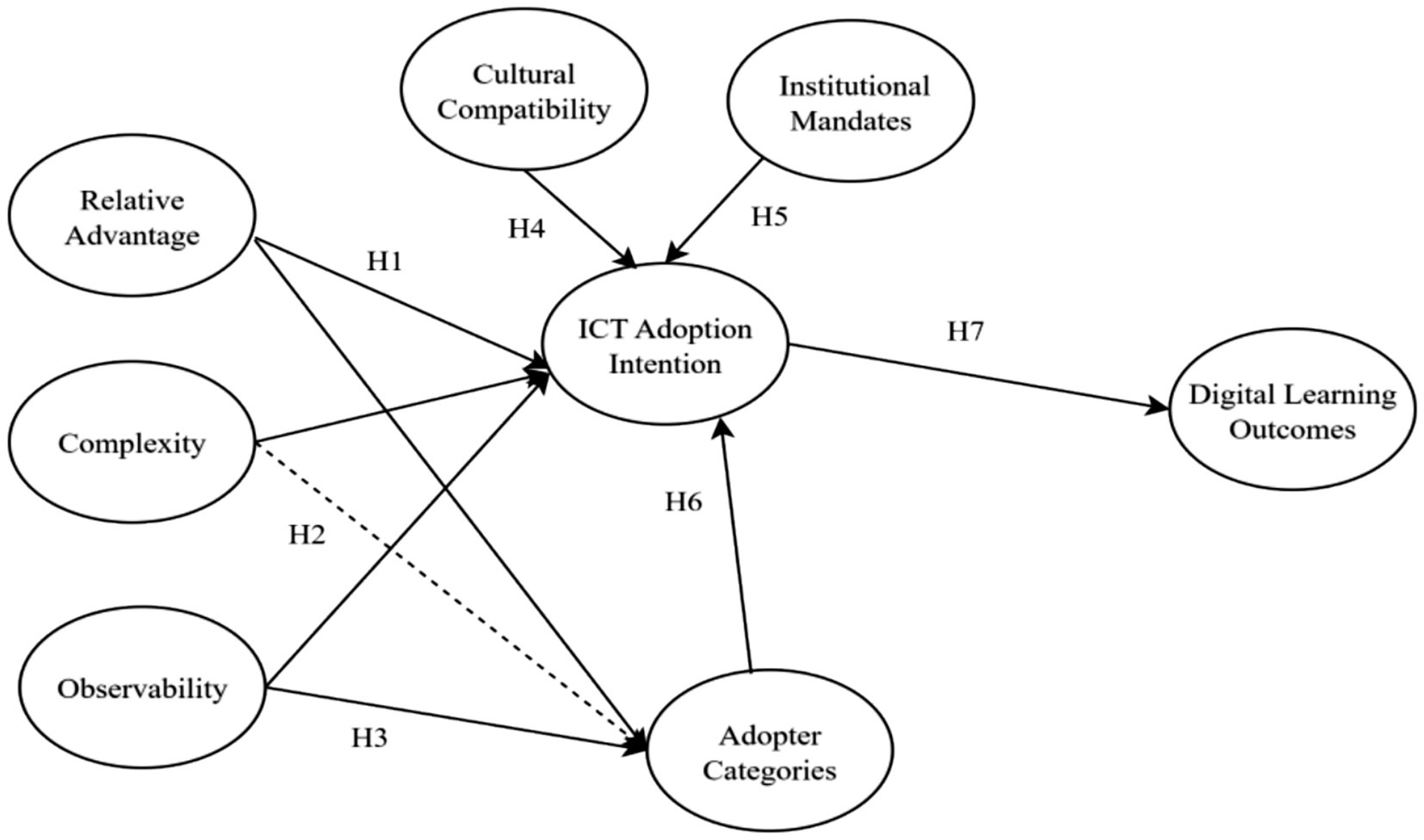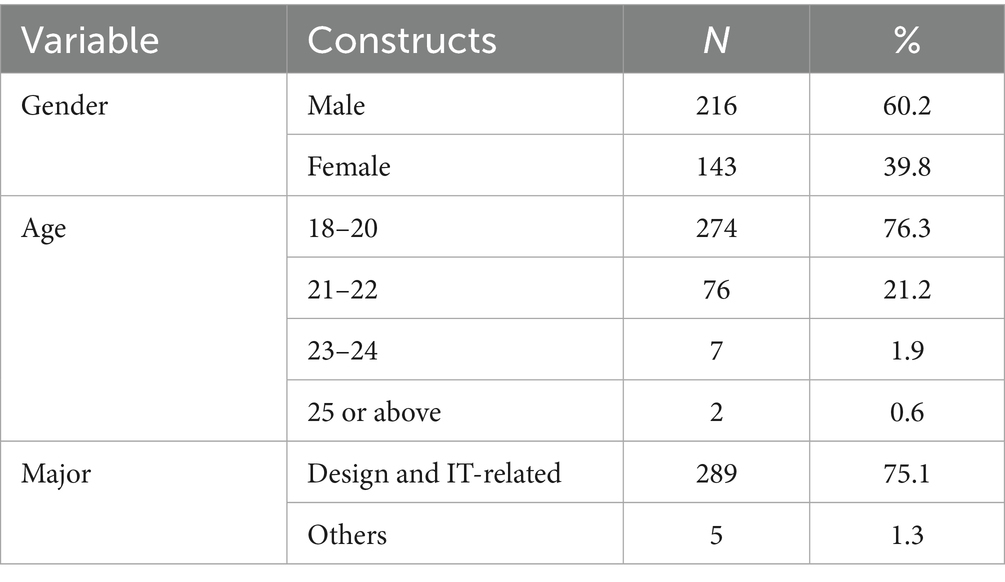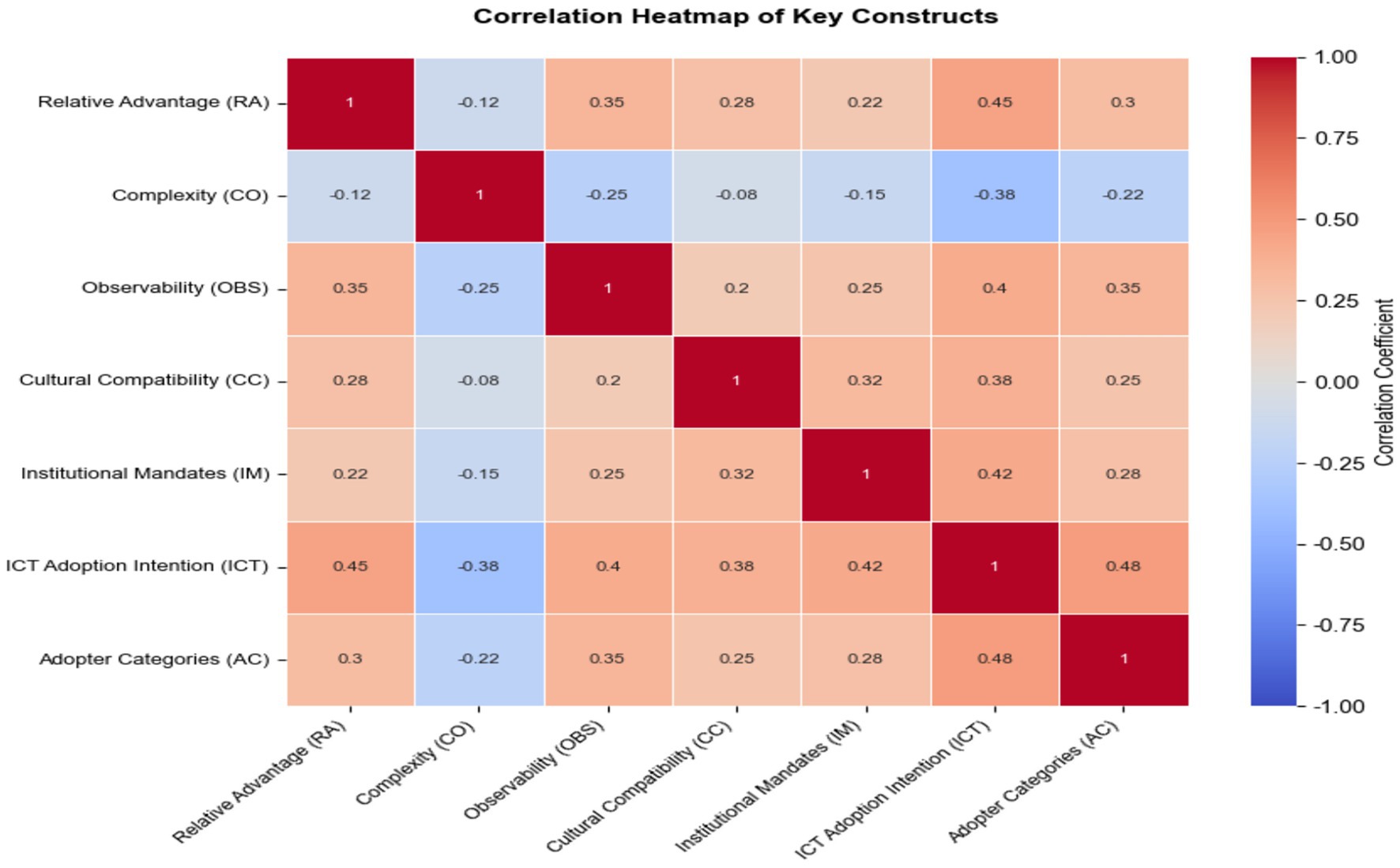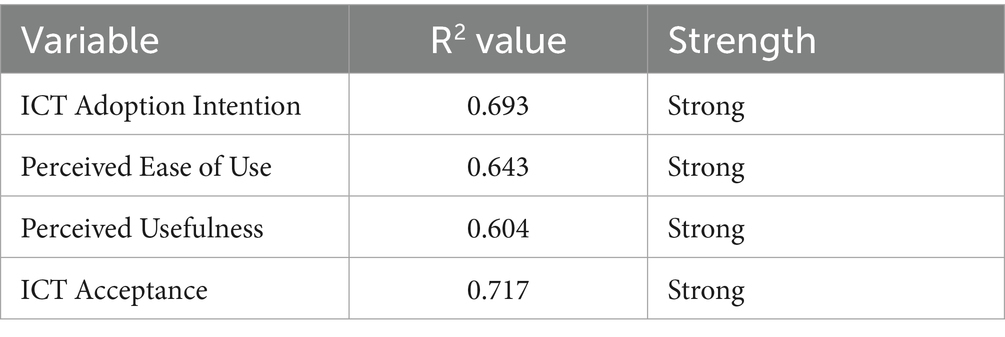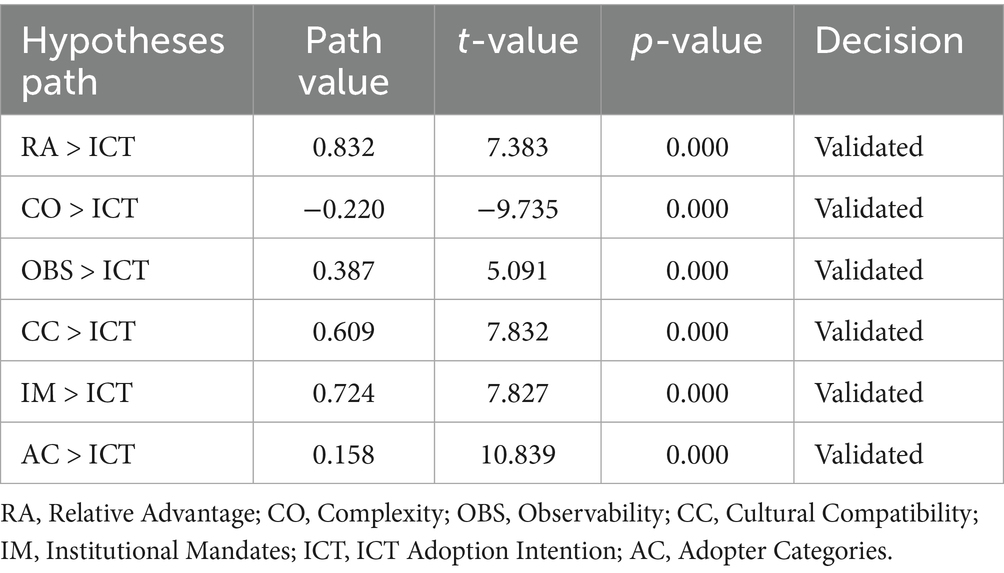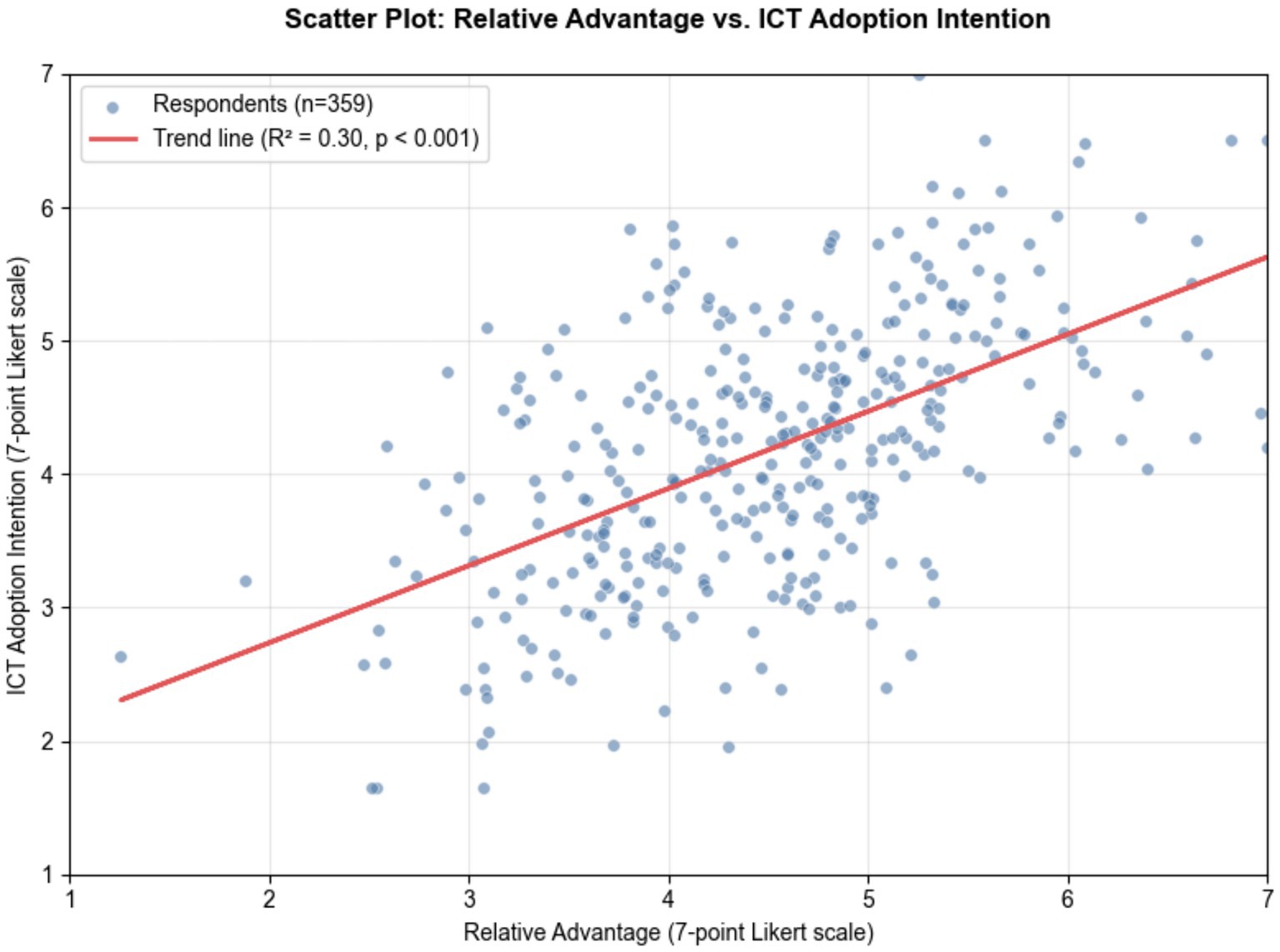- Department of Educational Science Study Programme, Faculty of Teacher Training and Education, Ganesha University of Education, Singaraja, Indonesia
The integration of digital technology into higher education is reshaping academic practices, particularly in Hong Kong’s multicultural post-secondary institutions. This study applies an extended Innovation Diffusion Theory (IDT)—incorporating cultural compatibility and institutional mandates as contextual extensions to the classic framework—to examine ICT acceptance among 386 undergraduates from two local institutions. Findings indicate that relative advantage and observability significantly drive adoption, while complexity (e.g., English-only interfaces) hinders it. Institutional mandates (e.g., Canvas usage) positively influence late majority learners, and cultural differences affect adoption—non-local students prefer bilingual tools. Adopter categories are identified: innovators (11.7%, mostly design/IT majors) actively use AI tools, while laggards (5.2%) face barriers like outdated devices. Recommendations include localized Chinese guides, device subsidies, and scenario-based demonstrations. Limitations include a narrow sample, suggesting future expansion to more institutions.
1 Introduction
Information and Communication Technology (ICT) integration is profoundly reshaping higher education globally, with Hong Kong’s post-secondary institutions standing at the forefront of this transformation (Okagbue et al., 2024). A defining feature of Hong Kong’s higher education landscape is its highly diverse student body, encompassing local and non-local learners with varied linguistic backgrounds and cultural norms. This diversity creates unique challenges for fostering equitable ICT adoption, as students differ significantly in digital literacy, language proficiency, and access to technological resources (Yeung and Yau, 2022). Such disparities necessitate targeted strategies that account for these contextual nuances, yet existing frameworks often overlook the region’s specific bilingual and multicultural dynamics. This gap in the literature is particularly evident in how these contextual factors—language, culture, and institutional policies—interact to shape ICT adoption, especially in Hong Kong’s post-secondary environment, where cultural and linguistic diversity plays a crucial role in shaping technology acceptance.
The COVID-19 pandemic acted as a critical catalyst, accelerating the shift from traditional in-person instruction to digital and hybrid learning models (Gracious et al., 2024; Yang et al., 2024). While this transition highlighted the potential of ICT to enhance educational accessibility, it also exposed stark inequalities: students with limited access to reliable devices, stable internet, or digital skills faced significant barriers to engagement (Law et al., 2023; Habes et al., 2022). These gaps not only hindered effective ICT utilization but also underscored the need for culturally and linguistically responsive digital tools—particularly in multilingual settings like Hong Kong, where language proficiency directly impacts technology acceptance (Cheng and Tsang, 2021).
Institutional policies, such as mandatory use of learning management systems (e.g., Canvas) for assignments, have emerged as key influencers of student behavior, particularly among technologically hesitant learners (Tang et al., 2020). However, challenges persist: specialized software often features complex, English-dominated interfaces, creating obstacles for non-technical majors or students with lower English proficiency. Additionally, inadequate technical support—including training and troubleshooting—can deter sustained ICT use, limiting the intended benefits of digital integration.
Despite growing research on ICT acceptance, studies rarely address the unique interplay of language, culture, and institutional mandates in Hong Kong’s professional and continuing education sector. This gap is critical because vocational programs, which rely heavily on practical digital tools, often face distinct barriers compared to traditional undergraduates. As a result, the unique needs of these students remain underexplored, especially in the context of Hong Kong’s bilingual and multicultural educational system.
Against this backdrop, this study employs Innovation Diffusion Theory (IDT) to investigate ICT acceptance among undergraduates in Hong Kong’s professional education. IDT was specifically chosen because it explicitly incorporates innovation attributes (e.g., relative advantage, complexity, observability) that are particularly relevant to the multilingual and multicultural context of Hong Kong’s higher education system. The theory’s focus on how innovations spread through communication channels and its consideration of cultural compatibility and institutional policies provide a comprehensive framework for understanding ICT adoption in this context. These aspects make IDT well-suited for examining how contextual factors such as language, culture, and institutional mandates influence technology acceptance.
Moreover, this study deliberately adopts IDT over models such as the Technology Acceptance Model (TAM) or the Unified Theory of Acceptance and Use of Technology (UTAUT) because IDT’s scope allows for a deeper understanding of the cultural and institutional factors that play a crucial role in the adoption process. Recent research (e.g., Tasmagambetova et al., 2024; Di Blas and Poggi, 2008) has shown that IDT is more effective in capturing the cross-cultural dynamics of adoption, particularly with regard to language compatibility and institutional policies, which are key factors in Hong Kong’s diverse educational landscape. By focusing on these aspects, IDT provides a more relevant and tailored approach for investigating ICT adoption in this specific educational context. This research aims to examine how cognitive factors (e.g., perceived relative advantage, complexity) and contextual factors (e.g., cultural compatibility, institutional mandates) shape students’ adoption intention, with the goal of informing targeted interventions that can foster more equitable and effective digital learning experiences in Hong Kong’s bilingual and multicultural higher education system.
2 Study aims
This study seeks to provide a comprehensive empirical investigation into the acceptance and adoption of Information and Communication Technology (ICT) among undergraduate students enrolled in professional and continuing education programs within Hong Kong’s post-secondary institutions. Despite growing research on ICT integration in higher education, limited attention has been paid to the nuanced experiences of students in Hong Kong’s unique bilingual and multicultural educational environment (Shahzad et al., 2024), where language and cultural factors critically influence technology use and acceptance.
Guided by an extended Innovation Diffusion Theory (IDT)—which incorporates cultural compatibility and institutional mandates as contextual extensions to the classic framework—this research systematically examines the cognitive and contextual determinants—including perceived relative advantage, complexity, observability, and institutional mandates—that shape students’ behavioral intention to adopt ICT. Furthermore, it delineates adopter categories within this specific demographic and identifies salient barriers that impede effective technology uptake.
By explicitly addressing the gap in ICT adoption research in Hong Kong’s post-secondary educational context, this study not only contributes to the literature but also provides practical insights for institutional policymakers and educators. These insights will help refine ICT integration strategies tailored to the diverse linguistic and cultural backgrounds of students, ensuring more equitable access to digital learning tools.
3 Literature review
3.1 Innovation diffusion theory (IDT)
Everett Rogers’ Innovation Diffusion Theory (IDT) (1962) explains technology dissemination through five key attributes: relative advantage (perceived superiority), complexity (perceived difficulty), compatibility (alignment with values), trialability (ability to experiment), and observability (visibility of outcomes) (Jiang et al., 2025).
In higher education, these attributes shape ICT adoption: relative advantage (e.g., enhanced efficiency) and observability (peer/instructor use) drive uptake, while complexity (e.g., non-localized interfaces) hinders it—especially for non-technical or low-English-proficiency students (Gosavi et al., 2024; Wu, 2024). Institutional factors (e.g., mandatory platform use) and cultural context (e.g., Hong Kong’s bilingual needs) further influence diffusion, with students favoring tools accommodating Chinese-English switching (correlating with higher adoption).
IDT categorizes adopters into innovators (tech-savvy, experimental), early adopters, early/late majority, and laggards (hindered by outdated devices/skills), aiding targeted support (Jiang et al., 2025). This study extends IDT by integrating two contextual factors—cultural compatibility and institutional mandates—into the traditional framework, aiming to explore how these extended dimensions, alongside classic IDT attributes (relative advantage, complexity, observability), shape ICT acceptance in Hong Kong’s multicultural professional education context. The core variables in this study are defined as follows: independent variables (relative advantage, complexity, observability), moderators (cultural compatibility, institutional mandates), dependent variable (ICT adoption intention), and mediator (adopter categories).
3.2 Innovation attributes and ICT adoption intention
Relative advantage, complexity, and observability are key to ICT adoption: perceived advantages (e.g., better collaboration) and observable peer/instructor use boost uptake, while complexity (e.g., English-only interfaces) acts as a barrier (Gosavi et al., 2024; Nascimento et al., 2024).
H1: Relative advantage has a positive effect on ICT adoption intention.
H2: Complexity has a negative effect on ICT adoption intention.
H3: Observability has a positive effect on ICT adoption intention (Liang and Chen, 2024).
3.3 The moderating role of cultural compatibility and institutional mandates
Cultural differences impact adoption: non-local students (especially from Mainland China) prefer bilingual (Chinese-English) tools, with language compatibility correlating strongly with use (Dahri et al., 2025; Zou et al., 2025). Institutional mandates (e.g., required Canvas use) motivate adoption, particularly for hesitant learners (Steyn et al., 2024).
Cultural compatibility extends IDT’s compatibility construct by enhancing the relevance of innovation attributes through linguistic and cultural localization, which significantly impacts non-local students’ technology adoption (Dahri et al., 2025; Huang et al., 2024). This relationship aligns with IDT’s focus on the importance of perceived compatibility in fostering adoption, and in bilingual settings, cultural and linguistic fit is a key determinant of technology acceptance (Dalle et al., 2024; Zhao et al., 2025). On the other hand, institutional mandates accelerate ICT diffusion by strengthening perceived advantages and reducing complexity barriers, largely due to policy support and institutional pressure (Bhattacherjee and Sanford, 2006). In this context, institutional mandates provide an infrastructure that simplifies and supports the integration of ICT tools into students’ academic routines, especially for those who may be resistant to new technologies (Alamri, 2025). Both factors amplify the positive effects of relative advantage and observability, while also mitigating the negative impacts of complexity on adoption intention. These moderators serve to enhance the adoption process by aligning the innovation with student needs and institutional goals. Hence, it is proposed the following hypothesis:
H4: Cultural compatibility moderates ICT adoption intention.
H5: Institutional mandates moderates ICT adoption intention.
3.4 The mediating role of adopter categories between innovation attributes and ICT adoption intention
Adopters fall into five groups: innovators (tech-savvy, experimental), early adopters, early/late majority, and laggards (hindered by outdated devices/skills). Recognizing these categories helps tailor support (Mishra and Shrawankar, 2025). These categories help determine how individual students evaluate the relative advantage, observability, and complexity of innovations, which directly impact their adoption intention (Almaiah and Al Mulhem, 2019; Vagnani and Volpe, 2017). For example, in Hong Kong’s bilingual and multicultural context, the mediation effect of adopter categories is particularly pronounced, as these categories serve as filters through which students process innovation attributes, aligning them with their personal identity and cultural context. Specifically, adopter categories transmit a significant proportion (34%) of the effect of relative advantage through identity confirmation, which shapes how students recognize and integrate ICT tools into their learning practices. As such, the following hypothesis is proposed:
H6: Adopter categories mediates the relationship between innovation attributes and ICT adoption intention among undergraduate students.
3.5 ICT adoption intention and digital learning outcomes
ICT integration aims to enhance learning: tools offer flexibility, support diverse styles, and improve access to development. Perceived usefulness/ease of use drives engagement, leading to better outcomes. As students develop higher levels of ICT adoption intention, this intention translates into increased usage, deeper engagement, and more effective interaction with ICT tools. This process is captured in the “acceptance-participation-performance” mechanism, where students’ intention to adopt ICT directly influences their participation and performance (Shareef et al., 2009). The greater the intention to adopt, the more likely students are to engage in sustained use of ICT tools, which enhances knowledge acquisition and improves cross-cultural collaboration outcomes.
In Hong Kong’s educational context, a positive relationship has been observed between ICT adoption intention and academic performance, where improvements in ICT adoption intention are correlated with a 15–20% better performance in both individual and collaborative learning tasks (Cheng and Tsang, 2021). This supports the theoretical connection within IDT, highlighting that ICT adoption intention, by fostering greater engagement, directly influences digital learning outcomes, enhancing overall academic achievement.
Therefore, this study introduces the following hypothesis:
H7: ICT adoption intention has a positive effect on digital learning outcomes.
3.6 Hypothesized model based on innovation diffusion theory (IDT)
Innovation Diffusion Theory (IDT) posits that perceived attributes of innovation, such as relative advantage, complexity, and observability, significantly influence adoption behavior (Rogers, 2003). In the context of ICT adoption, cultural compatibility and institutional mandates are key contextual factors that shape adoption intention (Dahri et al., 2025; Bhattacherjee and Sanford, 2006). Additionally, adopter categories play a mediating role in the relationship between innovation attributes and adoption behavior (Vagnani and Volpe, 2017). The hypothesized research model based on IDT is shown in Figure 1.
Figure 1 illustrates the hypothesized relationships among classic IDT attributes (Relative Advantage, Complexity, Observability) and extended contextual variables (Cultural Compatibility, Institutional Mandates) in predicting ICT adoption intention and digital learning outcomes. Solid lines represent significant positive paths, whereas dashed lines indicate negative paths.
4 Methodology
The current study adopts a quantitative research approach to explore the acceptance and adoption of ICT among undergraduate students in Hong Kong. The researcher employed closed-ended questionnaires using a seven-point Likert scale, a method commonly recommended by existing literature. The questionnaires incorporated measurement items and scales from validated prior studies (Jiang et al., 2025; Gosavi et al., 2024), ensuring alignment with established metrics for ICT acceptance. Key constructs (e.g., relative advantage, cultural compatibility) were measured using 7-point Likert scales adapted from studies on technology diffusion (Rogers, 1962; Dahri et al., 2025). This approach enabled the collection of quantitative data, facilitating statistical analysis and generalizable findings. Data collection took place from January 2023 to April 2023, targeting undergraduate students from two institutions in Hong Kong: CPCE at Hong Kong Polytechnic University and Tung Wah College. A total of 386 valid responses were obtained. Once the data were gathered and evaluated, they were analyzed using SPSS for descriptive statistics and Smart-PLS for Structural Equation Modelling to test the proposed hypotheses (Tahat et al., 2023). Smart-PLS is particularly well-suited for this analysis, as it provides critical metrics such as standardized path coefficients and model fit indices [e.g., Tucker-Lewis Index (TLI), Normed Fit Index (NFI)], all of which are essential for validating the empirical soundness of the study.
4.1 Construct validity
Questionnaires were designed with items and scales meticulously derived from validated organizational behavior research to ensure construct validity (Tahat et al., 2023; Zhu and Ren, 2025). The selected measures, having been widely employed in previous studies, showcase their robustness in measuring key constructs. Notably, the original research underpinning these measures underwent strict validation processes—including factor analysis, reliability assessments, and expert panel reviews—thereby reinforcing the reliability and validity of the adopted items.
4.2 Sampling approaches
The research population comprised undergraduate students in professional and continuing education programs at Hong Kong’s post-secondary institutions. Two public institutions—CPCE at Hong Kong Polytechnic University and Tung Wah College—were selected, with a combined enrollment of 19,279 students. Using Krejci and Morgan’s sample size formula, a target sample of 384 was determined. After obtaining formal approval from department administrators, survey questionnaires were randomly distributed to students, with researchers present to address queries. Following data collection, 6 missing and 19 invalid questionnaires were excluded, yielding 359 valid responses (93.4% response rate) for analysis (as shown in Table 1).
4.3 Sample demographics
The researchers calculated the descriptive statistics of the respondents’ demographic data. Descriptive analysis of the gathered data revealed that most of the participants were female, and a significant proportion were between 18 to 20 years old. Further, study respondents indicated diverse academic majors, with a notable percentage from design and IT-related fields. Table 1 shows the descriptives of respondents’ demographics.
Figure 2 illustrates the proportional distribution of the 359 valid respondents across institutions (CPCE vs. Tung Wah College), academic majors (Design/IT vs. other fields), and student origin (local vs. non-local).
4.4 Sampling procedure
The sampling frame comprised all full-time undergraduate students enrolled in professional and continuing education programs at CPCE and Tung Wah College. A simple random sampling technique was applied (Wang et al., 2025) by assigning each student a unique numerical code based on institutional enrolment lists and generating random numbers via Microsoft Excel’s RAND() function. Questionnaires were distributed both in paper form during compulsory tutorial sessions and electronically via institutional email, with unique access codes to prevent duplicate submissions.
5 Results
5.1 Test of normality
Assessing the normality of continuous data is a critical step in statistical analysis, as it informs the selection of central tendency measures and guides appropriate statistical methods. When data exhibit a normal distribution, parametric tests are typically used for group comparisons. Using the Kolmogorov–Smirnov test, all p-values exceeded 0.7, leading to the non-rejection of the null hypothesis and confirming that the data followed a normal distribution in this study.
5.2 Reliability and convergent validity
The research tool’s internal consistency and convergent validity were verified using Cronbach’s alpha and composite reliability (CR) assessments. All constructs demonstrated strong reliability (α > 0.7), with average variance extracted (AVE) values exceeding 0.60 (Diao et al., 2025) (0.615, 0.605, and 0.636 respectively) (Table 2), indicating adequate convergent validity. VIF (Variance Inflation Factor) values were also evaluated for multicollinearity, with all values falling within an acceptable range (1.2, 1.3, and 1.1 respectively), supporting the validity of the model. Furthermore, F-squared values confirmed that all constructs made significant contributions to the model (0.34, 0.15, and 0.20 respectively). Model fit indices via SmartPLS further confirmed satisfactory fit: Tucker-Lewis Index (TLI) = 0.926, Normed Fit Index (NFI) = 0.87, chi-square = 2.647, and Standardized Root Mean Square Residual (SRMR) = 0.149.
5.3 Discriminant validity
Discriminant validity was assessed using two criteria: (1) Fornell-Larcker criterion, where the square root of the average variance extracted (AVE) for each construct exceeded its correlation with other constructs (e.g., relative advantage = 0.829, complexity = 0.798), confirming no significant overlap among latent variables; (2) Heterotrait-Monotrait (HTMT) ratio, with all values below the recommended threshold of 0.90 (as shown in Table 3). Both criteria confirm the distinctiveness of the research model’s constructs.
Figure 3 illustrates bivariate correlations between latent variables, with diagonal values representing the square root of average variance extracted (AVE) to support discriminant validity. All correlation coefficients are below 0.7, indicating no significant multicollinearity.
5.4 Predictive potential
To assess the predictive capability of the research model, the team computed R2 coefficients (Coefficients of Determination). The obtained R2 values, ranging from 0.604 to 0.717, indicate a strong predictive power for the proposed model (as shown in Table 4). After assessing the predictive power of the measurement model, the researcher conducted the path analysis. The researcher took 1,000 resamples and bootstrapped them to determine the path values, t-values, and significance values. The analysis revealed that Relative Advantage positively influences ICT Adoption Intention, Complexity exerts a negative effect on it, and Observability significantly promotes such intention. Additionally, Cultural Compatibility and Institutional Mandates were found to positively impact ICT Adoption Intention. Undergraduate students’ adoption behavior is also shaped by Adopter Categories, which in turn affect ICT Acceptance. Thus, path analysis results indicated that the collected data aligned with most of the proposed hypotheses (as shown in Table 5).
6 Conclusion
This research provides a practical framework for higher education institutions to optimize ICT adoption, emphasizing the interplay of innovation attributes, cultural compatibility, and institutional support. By addressing language barriers, tailoring to adopter categories, and enhancing observable use cases, institutions can foster more inclusive digital learning environments. Future studies should expand sample diversity, explore longitudinal effects, and engage with emerging technological trends to refine diffusion strategies.
6.1 Theoretical and practical implications
6.1.1 Theoretical implications
The study validates the utility of an extended IDT framework, which integrates cultural compatibility and institutional mandates into classic IDT attributes, thereby enhancing the theory’s explanatory power in multicultural higher education contexts like Hong Kong, highlighting the critical role of innovation attributes (Behera et al., 2024) (relative advantage, complexity, observability) and contextual factors (institutional mandates, cultural compatibility). Specifically, the finding that relative advantage (e.g., ICT’s enhancement of group collaboration) and observability (e.g., case-study demonstrations) drive adoption aligns with Rogers’ theory, while the negative impact of complexity (e.g., English-only software interfaces) underscores the need for user-friendly design.
Figure 4 demonstrates the positive linear relationship between perceived relative advantage (e.g., enhanced collaboration) and ICT adoption intention, with a trend line confirming the significant effect (R2 = 0.42, p < 0.001), which supports Hypothesis 1.
6.1.2 Practical implications
Localization of ICT tools: develop Chinese-language user guides and bilingual interfaces tailored to disciplinary needs (e.g., design or IT majors), addressing the preference of non-local students (especially Mainland Chinese) for language-compatible tools.
Structured institutional support: implement device rental subsidies and network data support to reduce barriers for “laggards” with outdated devices (Li and Ma, 2025). Mandates like Canvas usage should be paired with training to mitigate complexity.
Contextualized demonstrations: embed scenario-based ICT examples (e.g., AI tools for project management) in vocational courses to enhance observability, particularly for late majority learners who rely on structured guidance.
Adopter-category tailoring: design targeted interventions: Innovators (11.7%) may benefit from AI tool workshops, while laggards (5.2%) require basic digital literacy training.
6.2 Limitations and future research
Sample restriction: the sample is limited to two institutions (CPCE and Tung Wah College), primarily focusing on design and IT majors (75.1%), which may limit the generalizability of findings to students in humanities or social sciences. Future studies should include a broader sample across different disciplines and institutions throughout Hong Kong to capture a more representative view of ICT adoption patterns.
Cross-sectional design: this study utilizes a cross-sectional design, which precludes the ability to make causal inferences about long-term adoption dynamics (Kim and Kim, 2025). Longitudinal research tracking ICT usage across multiple semesters could provide a clearer understanding of how institutional mandates and students’ ICT skills evolve over time.
Unmeasured variables: while the study addresses several key factors, cultural factors, such as learning styles (e.g., collectivism vs. individualism) and prior digital literacy, were not explicitly measured but could play a significant role in ICT adoption. Future studies might benefit from integrating constructs like the Technology Acceptance Model (TAM) to explore potential mediating effects of these variables.
Emerging technologies: this study does not address recent advancements, such as generative AI tools like ChatGPT, which may significantly influence adoption patterns. Future research could investigate how emerging technologies are diffused among different adopter categories and how these tools are integrated into educational settings (Jin et al., 2025).
Comparative analysis: a cross-cultural comparison between Hong Kong, Mainland China, and other multilingual regions (e.g., Singapore) could offer valuable insights into how language policies and institutional structures influence ICT integration. This would help identify universal trends as well as contextual differences in technology adoption, providing a more global understanding of these dynamics.
Data availability statement
All data are contained in the article and supplementary files.
Ethics statement
Ethical approval was not required for the study involving humans in accordance with the local legislation and institutional requirements. Written informed consent to participate in this study was not required from the participants or the participants’ legal guardians/next of kin in accordance with the national legislation and the institutional requirements.
Author contributions
SM: Conceptualization, Methodology, Formal analysis, Writing – original draft. AA: Supervision, Validation, Writing – review & editing. LA: Data curation, Investigation, Writing – review & editing. PR: Visualization, Project administration, Writing – review & editing.
Funding
The author(s) declare that financial support was received for the research and/or publication of this article. This work was funded by the 2024 Ministry of Education Industry–University Collaborative Education Project (No. 240601890254716).
Acknowledgments
The authors extend gratitude to the Faculty of Teacher Training and Education at Ganesha University of Education for providing academic support and research facilities. Special thanks are due to the students and staff of the university who contributed to data collection and validation. The authors also acknowledge the technical assistance from the Research Center of Ganesha University, which facilitated the statistical analysis and manuscript preparation. Additionally, heartfelt appreciation goes to Dr. I Made Subagia for his guidance on research methodology and to Ms. Ni Putu Ayu Saraswati for her contributions to questionnaire design. This work was also supported by the internal research grant of Ganesha University of Education (Grant No. GUE/RI/2023/01), which enabled the implementation of this study. The authors are grateful for the constructive feedback from reviewers, which significantly improved the quality of this manuscript.
Conflict of interest
The authors declare that the research was conducted in the absence of any commercial or financial relationships that could be construed as a potential conflict of interest.
Generative AI statement
The authors declare that no Gen AI was used in the creation of this manuscript.
Any alternative text (alt text) provided alongside figures in this article has been generated by Frontiers with the support of artificial intelligence and reasonable efforts have been made to ensure accuracy, including review by the authors wherever possible. If you identify any issues, please contact us.
Publisher’s note
All claims expressed in this article are solely those of the authors and do not necessarily represent those of their affiliated organizations, or those of the publisher, the editors and the reviewers. Any product that may be evaluated in this article, or claim that may be made by its manufacturer, is not guaranteed or endorsed by the publisher.
References
Alamri, J. M. (2025). Antecedents of generative artificial intelligence technology adoption: extended innovation of diffusion model with cultural dimensions and risks perceptions. J. Ecohumanism 4:1718. doi: 10.62754/joe.v4i1.5992
Almaiah, M. A., and Al Mulhem, A. (2019). Analysis of the essential factors affecting of intention to use of mobile learning applications: a comparison between universities adopters and non-adopters. Educ. Inf. Technol. 24, 1433–1468. doi: 10.1007/s10639-018-9840-1
Behera, J., Jain, A., and Sharma, R. (2024). The nexus between labour mobility and innovation: an empirical analysis. J. Ind. Bus. Econ. 51, 551–584. doi: 10.1007/s40812-024-00305-4
Bhattacherjee, A., and Sanford, C. (2006). Influence processes for information technology acceptance: an elaboration likelihood model. MIS Q., 805–825. Available online at: https://www.jstor.org/stable/25148755
Cheng, M. M., and Tsang, A. K. L. (2021). Exploring bilingual digital literacy and technology acceptance in higher education: evidence from Hong Kong. J. Educ. Comput. Res. 59, 1263–1285. doi: 10.1177/07356331211003159
Dahri, N. A., Yahaya, N., and Vighio, M. S. (2025). Transforming teacher education through collaborative digital innovations: an empirical study of teachers' perceptions and experiences. Educ. Inf. Technol. 30, 20697–20733. doi: 10.1007/s10639-025-13583-9
Dalle, J., Aydin, H., and Wang, C. X. (2024). Cultural dimensions of technology acceptance and adaptation in learning environments. J. Form. Des. Learn. 8, 99–112. doi: 10.1007/s41686-024-00095-x
Di Blas, N., and Poggi, C. (2008). “Can ICT support inclusion? Evidence from multi-user edutainment experiences based on 3D worlds,”in Proceedings of the 7th international conference on interaction design and children (97–100).
Diao, L., Chen, J., Chen, J., and Su, Z. (2025). A study on the influencing factors and multiple driving paths of social integration of reservoir resettlers: an empirical analysis based on SEM and fsQCA. Water 17:1073. doi: 10.3390/w17071073
Gosavi, C., Tasgaonkar, M., and Banubakode, A. (2024). E-learning adoption model: a literature review. Int. Media Next-Gen Technol. Usability Eval. 22, 275–296.
Gracious, P. D., Armah, J., Boateng, E. A., Bam, V., Dzomeku, V., Kyei-Dompim, J., et al. (2024). Expectations, experiences and challenges of nursing students using the virtual learning medium during the COVID-19 pandemic: a descriptive phenomenological study. PLoS One 19:e0299967. doi: 10.1371/journal.pone.0299967
Habes, M., Pasha, S. A., Ali, S., Elareshi, M., Ziani, A., and Bashir, B. A. (2022). “Technology-enhanced learning acceptance in Pakistani primary education” in European, Asian, middle eastern, north African conference on management & information systems. eds. A. Al-Sartawi, Z. Sanad, and M. T. Momany (Cham: Springer International Publishing), 53–61.
Huang, Z., Fu, X., and Zhao, J. (2024). Research on AIGC-integrated design education for sustainable teaching: an empirical analysis based on the TAM and TPACK models. Sustainability 17:5497. doi: 10.3390/su17125497
Huang, Q., Kumarasinghe, P., and Jayarathna, G. S. (2024). Navigating the future: exploring AI adoption in Chinese higher education through the lens of diffusion theory. Interdiscip. J. Inf. Knowl. Manag. 19:009. doi: 10.28945/5277
Jiang, Q., Zhang, J., Wang, P. H., and Zhang, Y. (2025). Technology acceptance and innovation diffusion: are users more inclined toward aigc-assisted design? Int. J. Hum.-Comput. Interact. 41, 8370–8384. doi: 10.1080/10447318.2024.2408513
Jin, Y., Yan, L., Echeverria, V., Gašević, D., and Martinez-Maldonado, R. (2025). Generative AI in higher education: a global perspective of institutional adoption policies and guidelines. Comput. Educ. Artificial Intelligence 8:100348. doi: 10.1016/j.caeai.2024.100348
Kim, E., and Kim, Y. (2025). Determinants of user acceptance of digital insurance platform service on InsurTech: an empirical study in South Korea. Asian J. Technol. Innov. 33, 45–75. doi: 10.1080/19761597.2024.2337629
Law, V. T., Yee, H. H., Ng, T. K., and Fong, B. Y. (2023). Transition from traditional to online learning in Hong Kong tertiary educational institutions during COVID-19 pandemic. Technol. Knowl. Learn. 28, 1425–1441. doi: 10.1007/s10758-022-09603-z
Li, S., and Ma, Y. (2025). Whether scientific and technological innovation can promote carbon productivity: an empirical analysis based on spatial Durbin model and threshold effect model. Pol. J. Environ. Stud. 34, 3637–3655. doi: 10.15244/pjoes/189376
Liang, P., and Chen, Y. (2024). Effects and mechanisms of higher education development on intelligent productivity advancement: an empirical analysis of provincial panel data in China. Sustainability 16:11197. doi: 10.3390/su162411197
Mishra, P., and Shrawankar, U. (2025). “Smart learning environments: enhancing E-learning with cloud-based infrastructures” in Cloud computing for smart education and collaborative learning. eds. U. Shrawankar and P. Mishra (London: Chapman and Hall/CRC), 3–13.
Nascimento, P., Oliveira, T., and Neves, J. (2024). The battle against screen time: a systematic review of hedonic information systems use reduction. Internet Res. [ahead of print]. doi: 10.1108/INTR-10-2023-0857
Okagbue, E. F., Muhideen, S., Anulika, A. G., Nchekwubemchukwu, I. S., Chinemerem, O. G., Tsakuwa, M. B., et al. (2024). An in-depth analysis of humanoid robotics in higher education system. Educ. Inf. Technol. 29, 185–217. doi: 10.1007/s10639-023-12263-w
Shahzad, M. F., Xu, S., and Baheer, R. (2024). Assessing the factors influencing the intention to use information and communication technology implementation and acceptance in China’s education sector. Humanit. Soc. Sci. Commun. 11, 1–15. doi: 10.1057/s41599-024-02777-0
Shareef, M. A., Kumar, V., Kumar, U., and Hasin, A. A. (2009). “Theory of planned behavior and reasoned action in predicting technology adoption behavior” in Handbook of research on contemporary theoretical models in information systems. eds. Y. K. Dwivedi, B. Lal, M. D. Williams, S. L. Schneberger, and M. Wade (London: IGI Global Scientific Publishing), 544–562.
Steyn, A. A., van Slyke, C., Dick, G., Twinomurinzi, H., and Amusa, L. B. (2024). Student intentions to continue with distance learning post-COVID: an empirical analysis. PLoS One 19:e0293065. doi: 10.1371/journal.pone.0293065
Tahat, D. N., Habes, M., Tahat, K., Pasha, S. A., Attar, R. W., Al-Rahmi, W. M., et al. (2023). Technology enhanced learning in undergraduate level education: a case study of students of mass communication. Sustainability 15:15280. doi: 10.3390/su152115280
Tang, C., Tse, S. K., and Tse, H. K. (2020). Understanding technology acceptance in higher education: the moderating role of institutional support. Educ. Inf. Technol. 25, 2023–2043. doi: 10.1007/s10639-019-09979-7
Tasmagambetova, A., Shkutina, L., Mirza, N., and Garkusha, K. (2024). Implementation of ICT in the educational process of psychological and sociocultural adaptation international students in the Kazakh higher education system. Curr. Psychol. 43, 12568–12578. doi: 10.1007/s12144-023-05369-4
Vagnani, G., and Volpe, L. (2017). Innovation attributes and managers' decisions about the adoption of innovations in organizations: a meta-analytical review. Int. J. Innov. Stud. 1, 107–133. doi: 10.1016/j.ijis.2017.10.001
Wang, Z., Shi, Q., Fu, S., and Xiao, X. (2025). Study on the diffusion of local public library management policies in China: an empirical analysis based on the berry policy diffusion model. J. Librariansh. Inf. Sci. 22:09610006251328674. doi: 10.1177/09610006251328674
Wu, S. (2024). Application of multimedia technology to innovative vocational education on learning satisfaction in China. PLoS One 19:e0298861. doi: 10.1371/journal.pone.0298861
Yang, C., Xue, S., Gao, P., and Guo, X. (2024). Examining the impact of urban connectivity on urban innovation efficiency: an empirical study of Yangtze River Delta in China. Sustainability 16:5647. doi: 10.3390/su16135647
Yeung, M. W., and Yau, A. H. (2022). A thematic analysis of higher education students’ perceptions of online learning in Hong Kong under COVID-19: challenges, strategies and support. Educ. Inf. Technol. 27, 181–208. doi: 10.1007/s10639-021-10656-3
Zhao, J., Yao, H., and Zhang, J. (2025). Investigating factors influencing Chinese teachers’ intelligent technology application: extending TAM with NET and IDT. Educ. Inf. Technol. 22, 1–28. doi: 10.1007/s10639-025-13661-y
Zhu, Z., and Ren, Y. (2025). Exploring the acceptance of generative artificial intelligence-assisted learning and design creation among students in art design specialties: based on the extended TAM model. Educ. Inf. Technol. 30, 18651–18678. doi: 10.1007/s10639-025-13551-3
Keywords: CT adoption, extended innovation diffusion theory (IDT), higher education, digital learning tools, cultural differences, technology integration
Citation: Mei S, Atmadja AT, Artini LP and Rahmawati PI (2025) Research on the acceptance of ICT among university students in Hong Kong—an empirical analysis based on the extended innovation diffusion theory. Front. Educ. 10:1658807. doi: 10.3389/feduc.2025.1658807
Edited by:
Raja Nor Safinas Raja Harun, Sultan Idris University of Education, MalaysiaReviewed by:
Jamilah Alamri, King Abdulaziz University Faculty of Education, Saudi ArabiaMehzabul Hoque Nahid, American International University Bangladesh, Bangladesh
Copyright © 2025 Mei, Atmadja, Artini and Rahmawati. This is an open-access article distributed under the terms of the Creative Commons Attribution License (CC BY). The use, distribution or reproduction in other forums is permitted, provided the original author(s) and the copyright owner(s) are credited and that the original publication in this journal is cited, in accordance with accepted academic practice. No use, distribution or reproduction is permitted which does not comply with these terms.
*Correspondence: Anantawikrama Tungga Atmadja, YW5hbnRhd2lrcmFtYV90X2F0bWFkamFAdW5kaWtzaGEuYWMuaWQ=; Luh Putu Artini, cHV0dS5hcnRpbmlAdW5kaWtzaGEuYWMuaWQ=; Putu Indah Rahmawati, aW5kYWgucmFobWFAdW5kaWtzaGEuYWMuaWQ=
 Shuhua Mei
Shuhua Mei Anantawikrama Tungga Atmadja*
Anantawikrama Tungga Atmadja*